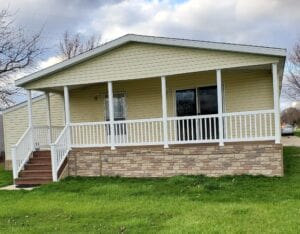Looking to create your dream oasis? Imagine having a mobile home nestled on your private land, offering freedom and flexibility like never before. With endless possibilities for customization and personalization, owning a mobile home on private land provides the ultimate blend of comfort and convenience. Are you ready to embrace a lifestyle where you call all the shots and design your perfect retreat? Elevate your living experience with a mobile home on private land – where every day feels like a getaway.
Understanding Zoning for Mobile Homes
Check Zoning Regulations
Before placing a mobile home on private land, check local zoning laws to ensure compliance with regulations. These laws dictate where and how mobile homes can be situated within a specific area.
Understand Restrictions
Understand zoning restrictions related to lot size and placement. Some areas may have minimum lot size requirements for mobile homes, while others may have specific setbacks from property lines.
Verify Land Zoning
It’s crucial to verify if your land is zoned for single-family residences before setting up a mobile home. Certain zones may not permit mobile homes or have restrictions on the number of dwellings allowed on a property.

Navigating Restrictive Covenants and HOAs
Review Restrictions
Review any existing restrictions or covenants on the property before proceeding with installing a mobile home. Ensure compliance with all regulations.
Seek Approval
Before placing a mobile home on private land, it is crucial to seek approval from the Homeowners Association (HOA). Failure to do so can lead to legal consequences.
Understand HOA Rules
Understanding the specific rules and regulations set forth by the HOA regarding mobile homes is essential. Each community may have different guidelines in place.
When dealing with restrictive covenants and HOAs, it is vital to be proactive and thorough in your research. Take the time to understand the legal implications of placing a mobile home on private land within these frameworks. By familiarizing yourself with the restrictions and seeking approval from the relevant authorities, you can ensure a smooth process without facing any unexpected challenges.
Complying with Manufactured Home Laws
Understanding State Regulations
Familiarize yourself with state regulations that govern the placement and installation of a mobile home on private land. Each state has specific laws dictating zoning, safety standards, and utility connections for manufactured homes.
Ensure compliance with HUD regulations, which set federal construction and safety standards for manufactured homes. These regulations cover aspects such as thermal protection, plumbing systems, and electrical wiring to guarantee safe living conditions for residents.
Obtaining Permits and Inspections
Obtain necessary permits from your local government before placing a mobile home on private land. These permits ensure that the installation meets all safety and zoning requirements mandated by the state and local authorities.
Schedule inspections to verify that your mobile home complies with all building codes and safety standards. An inspection by a qualified professional will confirm that the structure is safe for occupancy and adheres to all relevant regulations.
You might be interested in our article: How Much Does It Cost To Prepare a Mobile Home For Land

Evaluating Your Property for a Manufactured Home
Soil Quality
Assess the soil quality to ensure it can support the weight of a mobile home. Conduct soil tests to check for stability.
Access to Utilities
Consider the availability of water, electricity, and sewage connections on your land. Ensure these utilities are accessible for your home.
Setback Requirements
Verify if your property meets setback regulations for placing a mobile home. These setbacks determine the distance from property lines.
When evaluating your land for a manufactured home, pay attention to essential factors like soil quality, utility access, and setback requirements. Ensuring proper soil stability is crucial to prevent any structural issues with your home. Adequate access to utilities such as water and electricity is necessary for comfortable living conditions. Complying with setback regulations is vital to avoid legal complications when placing your mobile home on private land.
Placing Multiple Homes Per Acre
Density Regulations
Understanding the density regulations is crucial when considering placing multiple homes on a single acre of residential land. Each area has specific rules dictating the number of structures allowed per acre.
In some regions, you may find that different approaches are taken to determine the maximum number of homes permissible. These can include zoning laws, environmental considerations, and community guidelines. It’s essential to research and adhere to these regulations.
Infrastructure Needs
When planning to place multiple homes on your property, it’s vital to consider the infrastructure needs. This includes access to utilities such as water, electricity, sewage systems, and roadways. Ensuring each home has adequate connections is paramount for a comfortable living environment.
Creating a comprehensive plan for the infrastructure requirements will help avoid any issues or delays in the future. Consulting with professionals in construction and urban planning can provide valuable insights into meeting these needs efficiently.
Limitations on Homes per Acre
Before proceeding with placing multiple homes on your land, investigate if there are any limitations on the number of homes per acre. Some areas may have strict restrictions on density to maintain community aesthetics or prevent overcrowding.
Understanding these limitations is essential for compliance with local regulations and avoiding potential legal complications down the line. Be sure to check with local authorities or planning departments for clear guidelines on the maximum allowable number of homes per acre.
Read more on our article: How Big is 1 Acre of Land: Understanding Size & Value

Steps to Place a Manufactured Home on Your Lot
Site Preparation
To install a mobile home on your private land, start by leveling the ground where the home will sit. Next, install a sturdy foundation to ensure stability and longevity.
Transportation and Installation
Once the site is ready, transport the mobile home to your lot. Ensure it is securely placed on the prepared foundation to prevent shifting or damage during transit.
Utility Connection and Finishing Touches
After sticking the home in place, connect essential utilities like water, electricity, and sewage. Finally, complete any remaining finishing touches to make the home livable and aesthetically pleasing.
Pros: Quick setup process, cost-effective compared to traditional homes.
Cons: Limited customization options, potential zoning restrictions on placement.
Buying Land for Your Mobile Home
Researching Options
When buying land for your mobile home, research vacant land or private land options that allow for mobile homes. Look into home parks or areas zoned for mobile homes.
Consider the location of the land in relation to amenities and services. Proximity to grocery stores, schools, and healthcare facilities is essential for convenience.
Verifying Boundaries
Before making a purchase, verify the land boundaries to ensure that the property lines align with what you are expecting. Check for any potential easements that could affect your use of the land.
Ensure that the underlying land is suitable for placing a mobile home by checking with the county or city regarding zoning regulations. This step is crucial to avoid any legal issues in the future.
Cost Comparison of Land and Home
Land Purchase vs. Mobile Home Acquisition
When comparing the costs of purchasing land for a mobile home versus buying a manufactured home, several factors come into play. Real property prices can vary significantly based on location, with rural areas typically offering more affordable options compared to urban settings.
Ongoing Expenses Evaluation
After acquiring the land, ongoing expenses such as utilities, maintenance, and taxes need to be factored in. While owning the land outright may seem advantageous in terms of long-term investment, it also entails additional responsibilities and costs.
Pros of Land Purchase:
Potential increase in property value over time.
Greater control over customization and landscaping options.
Cons of Land Purchase:
Higher upfront costs due to purchasing the land.
Additional maintenance and tax obligations.
Financing Options Assessment
When considering financing options for both land and mobile home purchases, individuals can explore various avenues such as traditional mortgages, personal loans, or specialized financing for manufactured homes. Each option comes with its own set of fees and time commitments that should be carefully evaluated based on individual financial circumstances.
Adding Value with a Manufactured Home
Landscaping Enhancements
Enhance the curb appeal of your mobile home by investing in landscaping improvements. Planting colorful flowers, trimming bushes, and adding a fresh layer of mulch can significantly boost the overall look of your property. Consider installing pathway lighting to create a welcoming atmosphere for visitors.
Interior Upgrades
Upgrade the interior features of your manufactured home to increase its value. Simple updates such as replacing outdated fixtures, applying a fresh coat of paint, and installing modern flooring can make a big difference. Focus on enhancing the kitchen and bathrooms as these areas tend to have the most impact on potential buyers.
Outdoor Living Spaces
Boost the appeal of your mobile home by adding a porch or deck to create additional outdoor living space. This extension not only increases the usable square footage but also provides a cozy area for relaxation and entertainment. Consider incorporating outdoor furniture and decor to further elevate the charm of your outdoor space.
Summary
You’ve now gained a comprehensive understanding of placing a mobile home on private land. By navigating zoning laws, HOA regulations, and manufactured home laws, you’re equipped to evaluate your property and make informed decisions. Considering cost comparisons and the potential value addition of a manufactured home, you have the tools to proceed confidently. Remember, thorough research and adherence to legal requirements are crucial in this process. Your dream of owning a mobile home on private land is within reach with the right knowledge and approach.
FAQ’s: Mobile Home on Private Land
Is a mobile home real property?
Whether a mobile home is considered real property or personal property (chattel) depends on various factors, including how it is affixed to the land and its classification under local laws. In the United States, these are the key distinctions.
Can you put a mobile home on private property?
Yes, you can typically place a mobile home on private property, but there are several important considerations and steps to take: Zoning, regulations, permits, approvals, land preparation, foundation and utilities just to name a few. Always check with your local building offices first.
How much does it cost to put a mobile home on land?
The cost of placing a mobile home on land can vary widely depending on several factors, including the location, site preparation, utility connections, and any required permits or inspections.
You might be interested in our articles:
Stick Built Homes: Understanding the Significance
